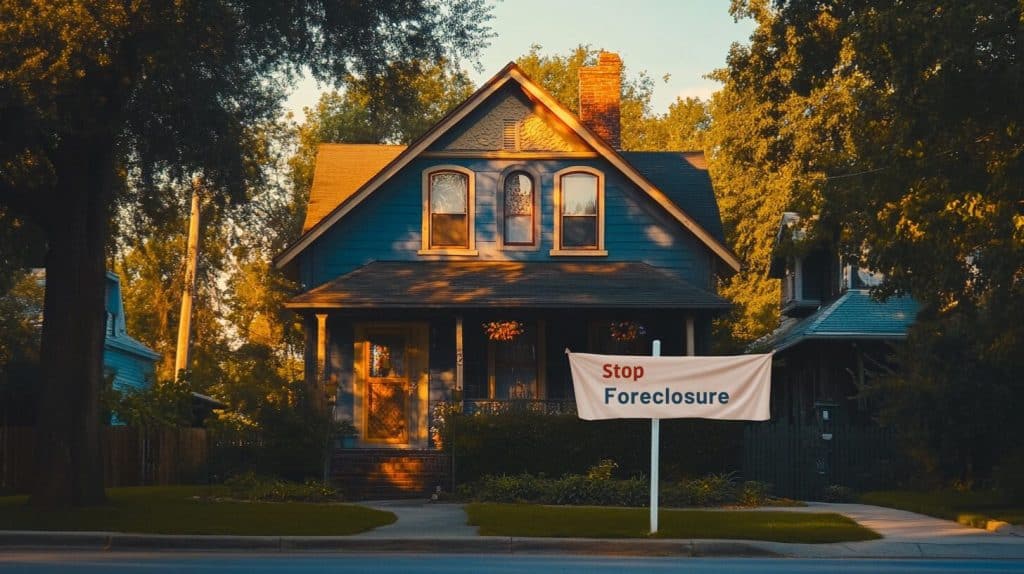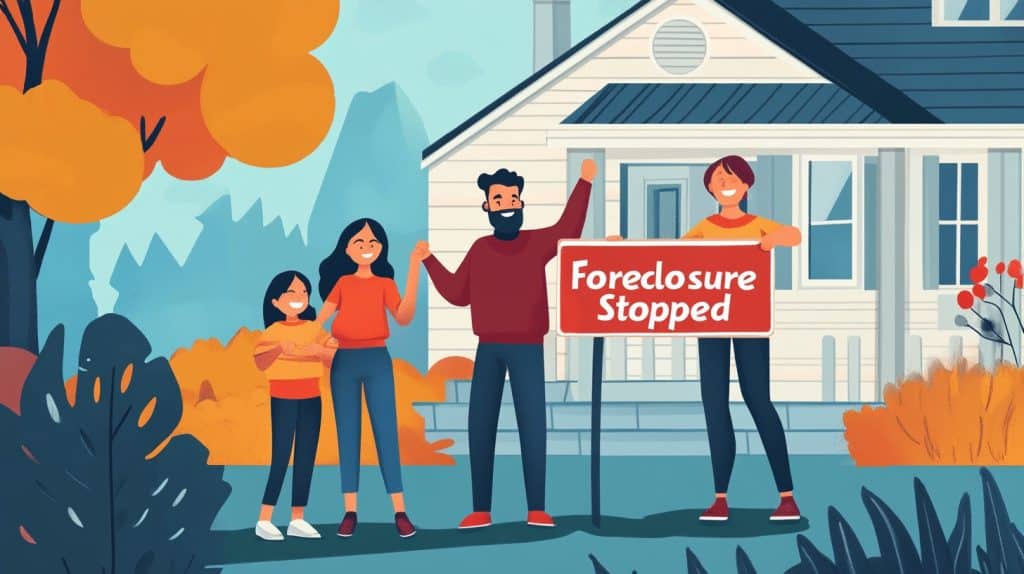MENU
Menu
Foreclosure can feel like an insurmountable challenge, but it doesn’t have to be the end of your homeownership journey. Even if you’ve fallen behind on mortgage payments, there are ways to stop foreclosure in California. This guide provides a roadmap to understanding the foreclosure process and taking action, with a special focus on resources available in San Bernardino and Riverside Counties.
Foreclosure is a serious situation where a homeowner may lose their home due to missed mortgage payments. In California, foreclosure is a complex process that involves several stages and legal requirements. Understanding the foreclosure process is crucial for homeowners who are facing foreclosure.
Foreclosure occurs when a homeowner fails to pay back a loan, and the lender takes possession of the property. This can also happen if the homeowner fails to pay property taxes. Common reasons for falling behind in payments include financial crises, medical emergencies, and job loss. Foreclosure is a widespread issue that can lead to severe consequences, including significant damage to credit scores and financial stability.

The foreclosure process begins when you miss your mortgage payments. After typically three to six missed payments, the lender issues a Notice of Default. This legal document is recorded at the County Recorder’s Office and serves as a formal notification that you are in default on your mortgage.
If the default is not cured, the Notice of Default is a precursor to foreclosure sales, which are scheduled to auction the property.
The Notice of Default is a critical juncture. It not only initiates foreclosure proceedings but also provides you with an opportunity to take corrective action. Ignoring this notice can accelerate the foreclosure process, making it more challenging to stop foreclosure later on.
California recognizes two primary types of foreclosures: non-judicial foreclosure and judicial foreclosure. Understanding the differences between these processes is crucial for homeowners facing foreclosure. Both types of foreclosures ultimately lead to foreclosure sales if the homeowner cannot resolve the default.
The most common method in California, non-judicial foreclosure, does not involve court proceedings. Instead, it follows a series of steps outlined in the California Civil Code. After issuing a Notice of Default, the lender must wait at least 90 days before scheduling a trustee sale. The trustee sale is then publicly announced, and the property is sold at a foreclosure auction.
Key features of non-judicial foreclosure:
Faster and less expensive than judicial foreclosure.
No right of redemption after the sale.
Lender cannot seek a deficiency judgment for the remaining mortgage balance.
Less common in California, judicial foreclosure involves filing a lawsuit against the borrower. This process is typically used when the lender wants to obtain a deficiency judgment. The court oversees the foreclosure, and the property is sold under judicial supervision.
Key features of judicial foreclosure:
Longer and more expensive process.
Borrower has a redemption period of up to one year.
Lender can seek a deficiency judgment for the unpaid loan balance.
Understanding why homeowners fall into foreclosure can help in finding solutions. Common reasons include:
Financial Hardships: Loss of job, medical expenses, or other unexpected costs.
Adjustable Interest Rates: Sudden increases in the interest rate leading to higher monthly payments.
Underwater Mortgage: Owing more on the mortgage loan than the property’s current market value.
Life Events: Divorce, death of a family member, or other significant life changes.
Missed mortgage payments not only initiate the foreclosure process but also severely impact your credit report. Each missed payment is reported to credit bureaus, leading to a drop in your credit score. This can affect your ability to secure future loans, rent properties, or even obtain certain jobs.

If you’re seeking information on how to stop a foreclosure sale in California, the goal of these options is to prevent foreclosure sales and keep homeowners in their homes. Several options are available:
Facing the possibility of losing your home is incredibly stressful. If you’re behind on your mortgage and worried about foreclosure in California, bankruptcy may be the solution you need.
Filing for bankruptcy can provide immediate relief from foreclosure through a powerful tool called the “automatic stay.” This court order puts an immediate halt to all foreclosure activities, giving you the time and space to explore your options and get back on your feet.
Chapter 7 Bankruptcy:
This type of bankruptcy can eliminate unsecured debts like credit card bills and medical expenses, freeing up your finances to focus on your mortgage.
In some cases, Chapter 7 may allow you to keep your home, depending on your equity and California’s exemption laws.
Chapter 13 Bankruptcy:
This option allows you to create a manageable repayment plan to catch up on missed mortgage payments over a period of 3 to 5 years.
You’ll make regular payments to your creditors through the bankruptcy court, while also staying current on your ongoing mortgage payments.
Chapter 13 is often the preferred choice for homeowners who want to keep their homes and have a steady income to support a repayment plan.

Why Choose Bankruptcy?
Immediate Protection: The automatic stay stops foreclosure actions instantly.
Repayment Options: Chapter 13 allows you to catch up on missed payments over time.
Debt Relief: Chapter 7 can eliminate unsecured debts, making your mortgage more manageable.
Fresh Start: Bankruptcy can provide a financial reset and a chance to rebuild.
Reinstating your mortgage involves paying off the loan amount that is in default. This typically means making a lump sum payment to cover all missed payments, including any late fees and penalties. Reinstating the loan can help homeowners avoid foreclosure and bring their mortgage current. In California, homeowners have up to three months to reinstate their loan after a Notice of Default (NOD) has been mailed to them. It’s essential to approach your lender to discuss reinstatement options as soon as you receive the NOD to prevent further escalation of the foreclosure process.
A loan modification involves altering the terms of your mortgage to make payments more affordable. This could include reducing the interest rate, extending the loan term, or adding missed payments to the end of the loan.
Refinancing involves taking out a new loan to pay off the existing mortgage. This can provide a lower interest rate or more favorable terms, making monthly payments more manageable. Refinancing can be a viable option for homeowners facing foreclosure, as it can help them avoid foreclosure by restructuring their debt. However, homeowners should carefully consider their credit score and overall financial situation before opting for refinancing. In California, refinancing may offer a lifeline to those struggling to keep up with their mortgage payments.
A repayment plan allows you to catch up on missed payments by adding a portion of the overdue amount to your regular payments over a set period.
A forbearance agreement temporarily suspends or reduces your mortgage payments. This option is suitable if you’re experiencing a short-term financial hardship.
A short sale involves selling your home for less than the mortgage balance. The lender agrees to accept the sale proceeds as full satisfaction of the debt.
A deed in lieu of foreclosure allows you to voluntarily transfer ownership of your property to the lender, releasing you from the mortgage obligations.
Hiring a foreclosure attorney is a critical step in preventing foreclosure. An experienced attorney can:
Review your loan documents for legal violations.
Represent you in court during a foreclosure lawsuit.
Negotiate with your mortgage lender on your behalf.
Help you understand complex California foreclosure laws.
Understanding California foreclosure law is essential. Key regulations include:
The California Homeowner Bill of Rights provides protections for homeowners, such as:
Prohibiting dual tracking, where lenders pursue foreclosure while negotiating a loan modification.
Requiring a single point of contact at the lending institution.
Allowing homeowners to sue lenders for significant violations.
In a judicial foreclosure, homeowners have a redemption period of up to one year to reclaim their property by paying the full amount owed.
A deficiency judgment occurs when the foreclosure sale doesn’t cover the entire loan balance. In California:
Non-judicial foreclosures do not allow for deficiency judgments.
Judicial foreclosures may allow lenders to pursue the remaining balance.
Non-judicial foreclosures follow a specific timeline:
Notice of Default: Issued after missed payments.
Reinstatement Period: Homeowner has 90 days to catch up on payments.
Notice of Trustee Sale: Filed if default isn’t cured.
Trustee Sale: Property is sold at a public foreclosure auction.

The trustee sale is scheduled at least 20 days after the Notice of Trustee Sale. The auction date is announced publicly, and the sale proceeds are used to pay off the mortgage debt.
In a judicial foreclosure, the process includes:
Filing a Lawsuit: Lender files a complaint in court.
Court Proceedings: Both parties present their case.
Judgment: Court issues a foreclosure judgment.
Redemption Period: Homeowner may have up to one year to redeem the property.
Foreclosure Sale: Property is sold under court supervision.
Foreclosure has a significant negative impact on your credit report, potentially lowering your score by 200-300 points. This mark can remain on your report for up to seven years, affecting your ability to:
Obtain new credit.
Secure rental housing.
Qualify for certain jobs.

Contact Your Lender Immediately: Open communication can lead to solutions.
Review Your Mortgage Loan Documents: Understand your rights and obligations.
Seek Professional Advice: Consult a foreclosure attorney or HUD-approved housing counselor.
Avoid Foreclosure Rescue Scams: Be wary of companies promising quick fixes.
Several programs offer financial assistance to homeowners:
Making Home Affordable Program: Federal program providing loan modification options.
California Housing Finance Agency (CalHFA): Offers resources for struggling homeowners.
Local Nonprofits: Organizations in San Bernardino County and Riverside County provide support.
Legal representation ensures your rights are protected throughout the foreclosure process. An attorney can:
Challenge improper foreclosure actions.
Negotiate more favorable terms.
Represent you in court, if necessary.
Reviewing your loan documents can reveal errors or violations, such as:
Improper fees.
Misapplied payments.
Violations of California foreclosure law.
These issues can be used to contest the foreclosure.
Proactive engagement with your mortgage lender can lead to:
Loan modifications.
Repayment plans.
Temporary forbearance agreements.
Lenders often prefer to avoid foreclosure due to the costs involved.
Beware of foreclosure rescue companies that:
Charge upfront fees.
Guarantee to stop foreclosure.
Advise you to stop communicating with your lender.
Always verify the legitimacy of any company offering assistance.
A qualified real estate agent can assist with:
Evaluating your home’s market value.
Facilitating a short sale.
Providing insights into the local real estate market in San Bernardino County and Riverside County.
For homeowners aged 62 or older, a reverse mortgage can provide funds to pay off the existing mortgage, thus preventing foreclosure. This option converts home equity into cash without requiring monthly payments.
Foreclosure can have long-term effects on your financial situation, including:
Reduced credit score.
Difficulty obtaining loans.
Emotional stress and instability.
If foreclosure is unavoidable, steps to rebuild include:
Credit Repair: Monitor your credit report and dispute inaccuracies.
Financial Planning: Create a budget to manage expenses.
Rental Housing: Secure stable housing to re-establish creditworthiness.
Facing foreclosure is overwhelming, but taking immediate action can make a significant difference. Start by:
Contacting your lender.
Consulting a HUD-approved housing counselor.
Seeking legal advice from a foreclosure attorney.
Remember, you’re not alone, and resources are available to help you navigate this challenging time.
At The Law Offices of Edgar Lombera, we are dedicated to helping homeowners in San Bernardino County and Riverside County stop foreclosure and keep their homes. Our experienced team understands the complexities of foreclosure in California and will work tirelessly to find the best solution for your situation.
Call us today for a free consultation:
Redlands Office: 909-915-0181
Palm Springs Office: 760-835-9353
Don’t wait until it’s too late. Prevent foreclosure and secure your future by reaching out to our team of experts.
The non-judicial foreclosure process typically takes about 120 days from the Notice of Default to the trustee sale.
Yes, paying the total past-due amount, including fees, can reinstate your loan and stop the foreclosure.
Dual tracking occurs when a lender pursues foreclosure while simultaneously negotiating a loan modification. This practice is prohibited under the California Homeowner Bill of Rights.
In non-judicial foreclosures, deficiency judgments are not permitted. In judicial foreclosures, they are allowed unless prohibited by California law.
A deed in lieu of foreclosure is less damaging than a foreclosure but still negatively impacts your credit score.
The redemption period can be up to one year, allowing the homeowner to reclaim the property by paying the full amount owed.
Yes, a foreclosure attorney can explore legal defenses, negotiate with lenders, and guide you through alternatives to foreclosure.
A forbearance agreement is a temporary suspension or reduction of mortgage payments agreed upon by the lender.
A short sale is generally less damaging to your credit and allows you to have more control over the sale process.
Missed mortgage payments can significantly hurt your credit score, potentially dropping it by 50-100 points or more for each missed payment. The impact is worse for those with good credit and worsens with each additional missed payment. This damage can make it hard to get loans, rent apartments, or even land certain jobs.
To protect your credit, contact your lender immediately if you’re struggling to make payments. They may offer options to help you avoid foreclosure and minimize damage to your credit.
The Law Offices of Edgar P. Lombera is a federally approved debt relief agency dedicated to helping individuals use bankruptcy as a step to a brighter financial future. Contact us today to learn more about your bankruptcy options.